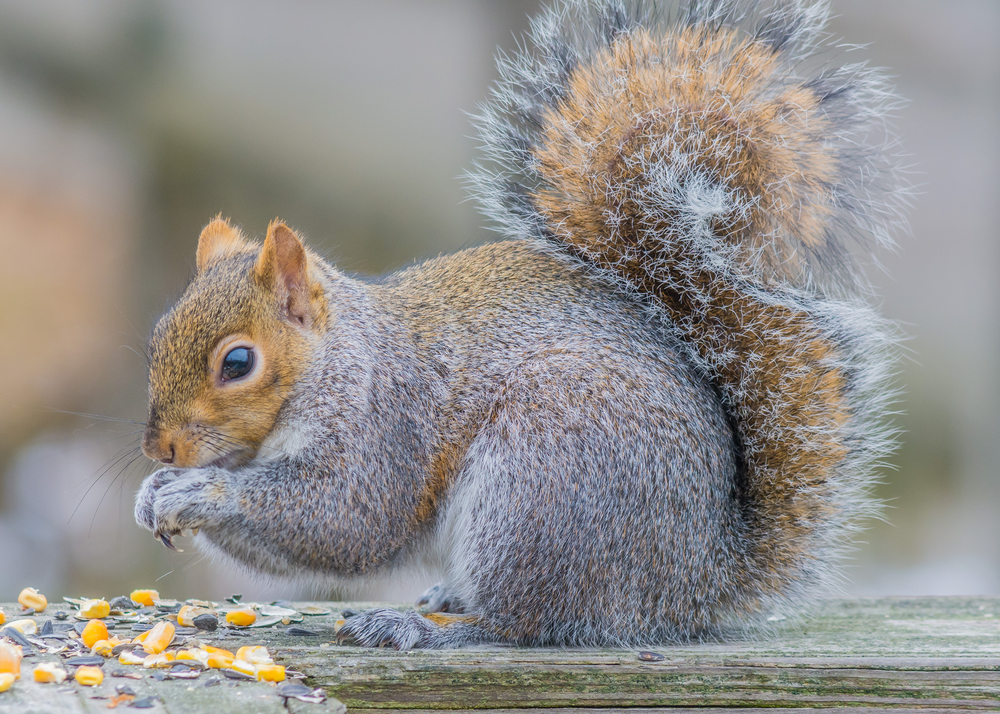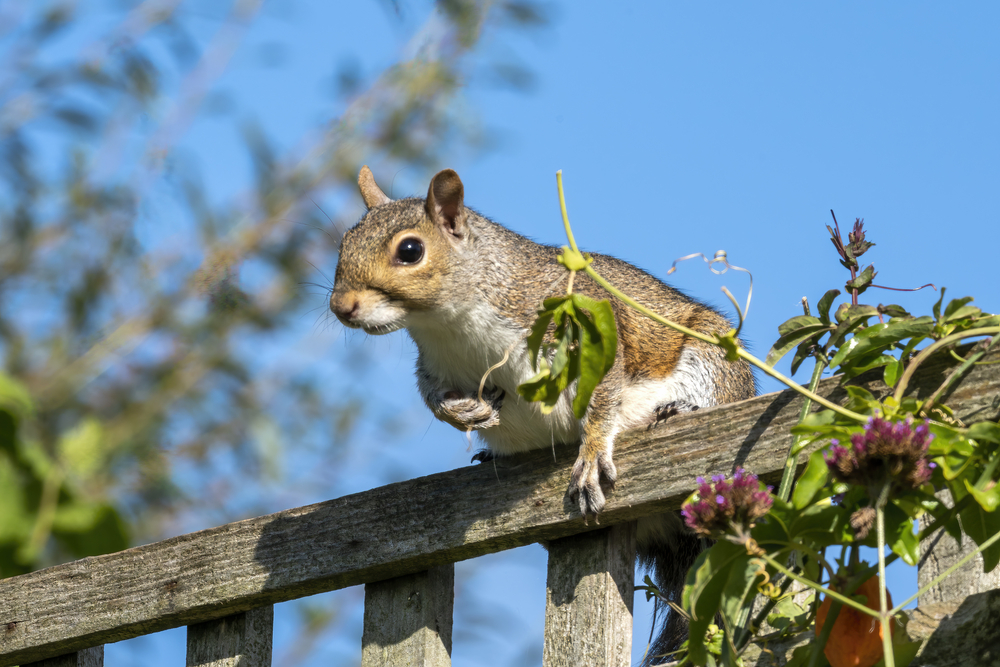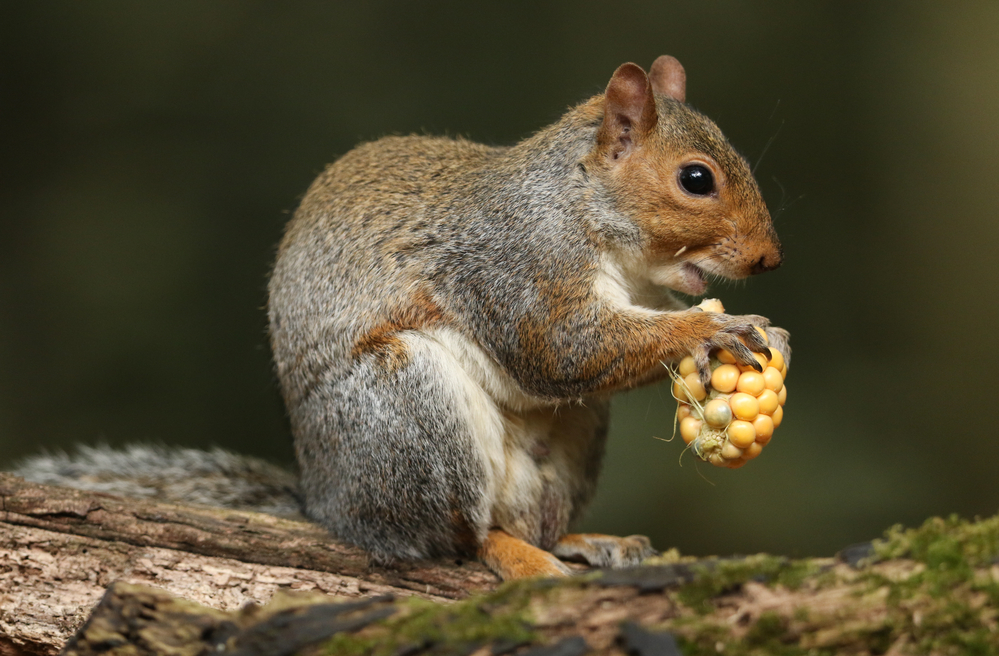The grey squirrel (Sciurus carolinensis) is one of the most recognisable species in the UK. These furry critters are found all over Britain, living and foraging in both urban and rural areas. But how much do you really know about these rodents? Learn more about their physical characteristics, habitat, diet and behaviour as we explore this iconic species. Discover why they’re such a common sight throughout Britain while also understanding what makes them so unique from other wildlife. So join us on our journey to uncover everything there is to know about the grey squirrel.
Overview
The grey squirrel (scientific name Sciurus carolinensis), also known as the eastern gray squirrel in its native to North America, is a tree squirrel in the genus Sciurus. It is believed they were introduced from North America to England in 1876 to populate the grounds of stately homes as ornamental species.
How To Identify a Grey Squirrel

The grey squirrel is a small to medium-sized rodent, measuring between 25 and 35 cm in length. Its fur ranges from light brown to blackish grey, with white patches on its underside and tail. The tail itself is long and bushy, usually measuring up to 25 cm in length. Grey squirrels have large eyes that are dark brown or black in colour, as well as sharp claws used for climbing trees. They also have distinctive tufts of fur around their ears which help them detect predators more easily.
Grey squirrels typically weigh between 400 and 600 grams, although some may be heavier depending on the season or food availability. Their bodies are slender but muscular; they have short legs with four toes on each foot, plus a thumb-like claw at the back of each hind foot for grooming purposes. Males tend to be slightly larger than females overall, but both sexes share similar physical characteristics otherwise.
Grey Squirrel Habitat

Distribution
The Sciurus carolinensis, or the eastern gray squirrel, is native to North America and can be found in many parts of the United States. In the UK, it has been introduced as an invasive species and is now widely distributed throughout England, Wales and Scotland. It prefers woodlands with a mix of deciduous trees such as oak and beech but can also be found in parks and gardens.
Habitat Requirements
Grey squirrels require a habitat that provides food sources (nuts), shelter from predators (trees) and access to water. They are most commonly found in mature woodland areas with plenty of trees for them to climb on or hide away in their nests which they build high up in tree hollows or between branches using leaves, twigs and bark strips. The squirrels will also make use of man-made structures such as bird boxes if available.
Grey Squirrel Diet

The main component of their diet is nuts, seeds, fruits and buds from trees such as oak, beech and chestnut. They also eat fungi, flowers and insects when available. In addition to these natural sources of food they will also take advantage of bird feeders or other human-provided sources if given the opportunity.
Grey squirrels are omnivorous animals that can survive on an array of foods including nuts, berries, grains and even small birds’ eggs or nestlings if they can get access to them. During winter months, when food supplies are scarce, they may turn to bark stripping from trees for sustenance as well as raiding gardens for vegetables like carrots or potatoes left by humans.
In order to store food during times when it’s abundant, grey squirrels have been known to bury caches in shallow holes near tree roots which they later return to at times when there is less food available naturally in their environment. This behaviour has earned them the nickname ‘scatter hoarders’ due to their tendency to hide away small amounts all over rather than storing large quantities in one place like some other species do.
Overall, the diet of grey squirrels varies depending on the season and habitat they inhabit. Generally speaking, this species relies heavily on plant matter, with occasional insect meals thrown into the mix for added nutrition throughout different parts of its life cycle.
Grey Squirrel Behaviour

Grey squirrels are diurnal animals, meaning they are active during the day. They typically spend their mornings foraging for food and then rest in a sheltered spot during the afternoon. Grey squirrels are very social creatures and can often be seen playing with each other or chasing one another around trees.
During breeding season, male grey squirrels will fight over territories and mates. These fights usually involve chasing each other up and down trees until one of them gives up or runs away.
Grey squirrels build nests called dreys which are made from twigs, leaves, mosses, bark strips and feathers that they collect from their environment. Dreys provide protection from predators as well as shelter from extreme weather conditions such as rain or snowfall. Grey squirrels may also use abandoned bird nests to make their own home if there is an available option nearby.
Grey Squirrel FAQs
Are grey squirrels invasive in the UK?
Yes, the grey squirrel is an invasive species. It was introduced to Britain from North America in the late 19th century and has since spread rapidly across much of England, Wales and Scotland. The grey squirrel outcompetes native red squirrels for food and habitat, leading to a dramatic decline in their numbers. In addition, it carries a virus which is deadly to red squirrels but not itself, further contributing to its displacement of native species. As such, it is considered one of the most damaging invasive species in Europe today. Grey squirrels are listed in the IUCN international list of 100 worst invasive non-native species.
Can a squirrel survive squirrel pox?
Squirrel pox is not fatal to grey squirrels, they have grown an immunity to it. The virus is, however, fatal to red squirrels. It causes lesions on the skin of infected animals and can lead to death in as little as two weeks. It is highly contagious and has been known to spread rapidly among populations of red squirrels.
Are grey squirrels vermin?
Yes, the grey squirrel is vermin, as per the law passed in 1981. This is due to the negative effect they have on the red squirrel, which has sent their population into decline.
Additional Resources
Sources and References
- Are Squirrels Rodents? – integrumservices.co.uk
- Grey squirrels – britishredsquirrel.org

Ash is a contributing author who has been writing about wildlife for as long as he can remember. He has a vast knowledge of many different types of animals, from the tiniest shrews to the great whales that live in the deepest oceans.

Recent research has shown a quarter of songbird nest failures can now be attributed to predation from eastern grey squirrels. They may also be partly responsible for the decline in the dormice population due to eating hazel nuts before they ripen..
You forget to add that Greys will raid bird nests and eat eggs as well as small chicks. They also deplete food sources for the reds as their digestive system can handle nuts and seeds that have not fully ripened. When spotting a grey it should be reported especially in an area that contains red squirrels as reds should be protected at all times.